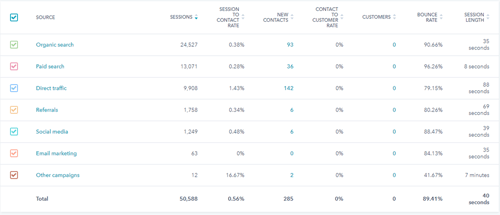
Blog

Is it Time to Bounce the Bounce Rate?
Web analytic metrics can range from the essential to the superfluous and everything in between.
Perhaps no digital marketing measurement has ricocheted between the useful and useless than the website bounce rate – an unreliable metric with comprehension that often proved as elusive and frustrating as trying to catch a bouncing “Super Ball” on the patio when you were a kid.
Follow the Bouncing Ball: Shifting Metrics Popularity
Wham-O, by the way, sold millions of Super Balls in the 1960s, and their popularity led to the naming of the “Super Bowl” after Kansas City Chiefs owner Lamar Hunt watched his children play with them.
By the mid-1970s, however, Wham-O ceased production of the Super Ball after too many knockoffs and competing products flooded the market.
Today, the bounce rate may be facing a similar fate as industry changes, especially with Google’s replacing Universal Analytics with Google Analytics 4 (GA4), which threatens to assign the bounce rate to the dustbin of metrics.
Many marketing experts are not mourning the demise of bounce rates.
“Bounce rate has always been a terrible metric. And now it’s even worse,” writes Lars Lofgren of Quick Sprout in August 2023. “In theory, the metric was supposed to give insights into what parts of your website pull in users and which parts repel them. In practice, it does neither.”
Judging from recent headlines, Lofgren is not tilting against windmills:
- Why Bounce Rate is No Longer an Important Metric
- Bounce Rate Doesn’t Matter
- What is Bounce Rate? Why This Common Metric Doesn’t Matter
- Bounce Rate is Dead – Long Live Engagement Rate
- Why Bounce Rate is Completely Useless
“Bounce rate is an overrated metric. When GA4 was introduced, it even disappeared for a while,” writes Logan Mastrianna in Data Driven in June 2023.
The Birth of the Bounce Rate
In the world of digital marketing, metrics are the compass guiding businesses toward success, and the concept of bounce rate was first introduced in web analytics to measure the percentage of visitors who land on a web page and then exit without interacting further.
It quickly became a popular metric because it seemed to offer a straightforward measure of user engagement. The lower the bounce rate, the better, or so it seemed.
The classic definition of a bounce rate, courtesy of Backlinko in 2019, is:
“Bounce Rate is defined as the percentage of visitors that leave a webpage without taking an action, such as clicking on a link, filling out a form, or making a purchase.”
For example, if 40 visitors leave a site without interacting with it and there have been 100 visitors overall, the bounce rate will be 40 percent. For some, a bounce rate between 50 and 70 percent was average.
The argument for the importance of your bounce rate from Backlinko was:
- Someone that bounces from your site (obviously) didn’t convert. So when you stop a visitor from bouncing, you can also increase your conversion rate.
- Bounce Rate may be used as a Google Ranking factor. In fact, one industry study found that Bounce Rate was closely correlated to first-page Google rankings.
- A high Bounce Rate lets you know that your site (or specific pages on your site) has issues with content, user experience, page layout, or copywriting.
Bounce rates in the early days of the Internet were a relatively useful metric because most websites were simple and single-paged, but as websites became more complex and multi-paged, bounce rates became less reliable.
Limitations of the bounce rate metric in providing a comprehensive view of website performance were affected by:
-
Changing User Behavior: Users today have shorter attention spans and may find what they need quickly. They could leave a page after finding the information they wanted, even though their visit was successful.
- Single-Page Websites: Bounce rate doesn't apply to single-page websites, which have gained popularity. Users can engage with the entire content on a single page without triggering any interactions that would prevent a bounce.
- Mobile Traffic: Many users browse websites on mobile devices, where interactions may be limited due to screen size or convenience. High bounce rates from mobile users do not necessarily indicate a lack of interest.
If that wasn’t enough, the introduction of GA4 in 2020 marked a significant shift in how bounce rates are viewed.
GA4 and Bounce Rates: Emphasis Shift to Engagement
GA4 started the transition to GA4 in 2020 and announced on July 1, 2023, that Universal Analytics properties will stop processing new data. Within the next 12 months, GA4 will be the only Google measurement solution.
“All users, including those accessing 360 properties, will lose access to the Universal Analytics user interface and API starting on July 1, 2024,” announced Google in July.
GA4 focuses on engagement rather than single-page visits. This is because GA4 recognizes that visitors may interact with a website in a variety of ways, such as scrolling, clicking links, and watching videos.
In this new way of measuring bounce rates, a user bounces if they:
- Spend less than 10 seconds on your site.
- Does not visit any other pages.
- Does not trigger a conversion event.
“If that feels like an insanely low bar for a user that doesn’t bounce, that’s because it is,” writes Lofgren.
Google would like you to focus on engagement vs. the bouncer rate (engagement and bounce rates always add up to 100 percent such that if your bounce rate is 40 percent then your engagement rate is 60 percent).
“The engagement rate is the percentage of engaged sessions on your website or mobile app. The bounce rate is the opposite of the engagement rate. The bounce rate is the percentage of sessions that were not engaged,” explains Google. “In other words, engagement rate helps you measure the percentage of visits to your website or app that involved some form of meaningful engagement.”
For instance, a user visits your website, reads some content for less than 10 seconds, and then leaves. While they were on your website, they didn't trigger any events or visit any other pages.
In this instance, because the user didn't match any of the criteria of an engaged session (the session was less than 10 seconds, no conversion event occurred, and there were not at least 2 pageviews or screen views), the session would not count as an engaged session. If this were the only session on your website, the engagement rate would be 0 percent and the bounce rate would be 100 percent.
“There’s no reason to look at both metrics. If you are going to use one of them, only use one. They both tell you the exact same thing,” says Lofgren. “I’d much rather spend time with metrics that give me clear answers.”
Other Metrics You Should Pay Attention To
In addition to engagement metrics, there are several other metrics that marketers should pay attention to when evaluating their websites. These include:
- Conversion Rate: The percentage of visitors who take a desired action, such as making a purchase or signing up for a newsletter.
- Average Session Duration: The average amount of time that visitors spend on the website.
- Pages Per Session: The average number of pages that visitors view per session.
- Traffic Sources: The channels that visitors are using to find the website, such as search engines, social media, or email.
- Exit Pages: The pages that visitors are most likely to leave from.
- Click-Through Rate (CTR): CTR measures the percentage of users who click on a specific link or call-to-action. It's particularly relevant for evaluating the performance of advertisements and email campaigns.
By tracking these metrics, marketers can get a better understanding of how visitors are interacting with their websites and identify areas where they can improve.
But I Still Want to Improve My Bounce Rate!
Letting go can be hard and some may still trust bounce rates as a useful metric. In this case, start by understanding that there is no one reason why a visitor may leave your website after viewing only one page. Reasons could include:
- They found the information they were looking for on the first page.
- They were interrupted by something else, such as a phone call or an email.
- They were not interested in the content of the website.
- The website was difficult to use or navigate.
To improve your bounce rate, try these tips:
- Make sure your website is easy to navigate.
- Use clear and concise language.
- Use high-quality images and videos.
- Offer visitors a reason to stay on your website, such as a free eBook or a discount code.
- Track your bounce rate and other metrics over time to see how you can improve.
Just remember that the bounce rate is a complex metric that should be interpreted with caution. There are other metrics and tools that provide you with an understanding of how visitors are interacting with your website and identify areas where you can improve.
Subscribe to email updates
Recent posts

Related Articles

Topics

Topics

Topics






